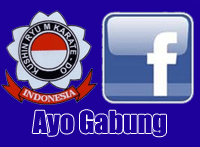Bisa dijadikan rujukan bagi karateka KKI di seluruh Indonesia untuk berlatih kata Suparinpei. Kata ini bisa digunakan oleh anggota KKI pada setiap pertandingan.
Selamat Belajar dan semoga sukses
OSS….!!!!
Kategori
-
Bergabung dengan 1.478 pelanggan lain





tolong lomba2 kejuaraan di sumsel lebih di perbanyak lagi
DAN BERIKAN PROGRAM UNTUK MENDOWNLOAD VIDEO2 INI
Osh..
Ade wijaya …Untuk program download video anda bisa cek di you tube.com
semoga berhasil
Osh….
Kita semua berharap semoga kejuaraan di daerah lebih banyak lagi untuk menambah jam terbang dalam bertanding
sipp !!!
Thank’s to Panji for visiting our site
oush……salam kenal ya fren…sy dari munggu,mengwi…dulu pernah belajar karate KKI dgn sempai made warta.munkin fren kanal?sayang karena kesibukan akhirnya cuma sampai biru aja.main2 juga ke blog saya ya?www.mansuka.blogspot.com
@mansuka: Osh …. Salam kenal juga kalo ada waktu bisa main-main atau kalo memang mau latihan bisa juga sambil cari keringat dan sehat tentunya
osh..
saya dari bekasi barat…
gerakan kata Suparinpei main nafas semua ya??
tp lumayan juga untuk saya pelajarin ke smuanya..
thx ya atas info kata nya..
@ruri : OK sama2, thank juga sudah berkunjung ke web kami
osh…
salam kenal saya dari karateka Gojukai, kata SUparinpei memang sulit dimainkan, tpi jika anda bisa melakukannya, anda akan mendapat kepuasan tersendiri.
btw di video ini ada 2 kata suparinpei yang berbeda. tapi prinsipnya tetap sama.
>>>>>
Introduction
The kanji traditionally used for Suparinpei mean “108 hands”. This is the longest of the Goju-ryu kata and is regarded as the most advanced. This kata utilizes many techniques and contains a great number of applications. Suparinpei not only contains many of the techniques from earlier kata but also introduces two kicks not found in any other Goju kata, specifically a mae tobi geri (jumping front kick) and mikazuki geri (crescent kick).
In the Academy 2 versions of the kata are practised, namely “Suparinpei sho” and “Suparinpei dai”. Suparinpei sho is the traditional kata which has a right sided bias. Suparinpei dai, as formulated in the Academy, repeats the kata on the left side (resulting coincidentally in a total of 108 moves).
Suparinpei is required for Yondan 3 and 4.
Suparinpei tuide
Suparinpei tuide is a 2 person “lock flow” drill, containing locks and holds found in Suparinpei.
It can be practised both standing and on the ground
Suparinpei tuide is required for Yondan 4.
Suparinpei embu
Suparinpei embu is a 2 person version of Suparinpei that can also be performed as a single person form.
Suparinpei embu is required for Yondan 4.
Origins and analysis
It is generally accepted that Kanryo Higaonna brought the Suparinpei kata back from Fuzhou where he learned the form from Ryu Ryu Ko, and that Higaonna then taught the kata to Chojun Miyagi.1
Suparinpei is presently taught in all Goju schools. Originally it is said that the kata was called “Pecchurin” () meaning “100 continuous techniques” (pronounced “Baijilian” in Mandarin) . Tou’on-ryu, the school founded by Juhatsu Kyoda, still calls the kata by this name. Their version is said to be substantially the same as, but not identical to, the Goju version. It is thought that Miyagi may have renamed the kata, although it not known why. Alternatively, the kata may have been known by both names.
It is interesting to note that Kanbun Uechi (founder of Uechi-ryu), who brought back from Fuzhou kata by the names of Sanchin, Sanseiru and Seisan, also knew of a kata named “Suparinpei”, however he did not have time to learn this kata during his time in China.2
Today there are no known weaponless forms named “Suparinpei” in Fujian province, although Martin Watts advises that there is a knife form in the Yong Chun school bearing that name. Researcher Akio Kinjo3 also states that he knows of a Yong Chun form named Pecchurin, pronounced “Baagirin”.
The name “Suparinpei” is composed of 4 characters, namely or “su” from the Japanese word “itsu” meaning “one” (the character is a formal way of writing the number in legal or official documents); or “pa” meaning “hundred”; or “rin” meaning literally “zero” or “fragment” but used in this context in the same way as the conjunction “and” would be used in English4; and meaning “8”. Accordingly the name means simply “108”. As with Sanseiru, Seipai and Seisan it is customary in Okinawa to add or “te” meaning “hands” at the end so that the name means “108 hands”.
dari Gojukai Sulawesi Utara,,,
Lam kenal semua dari teman2 KKI,
btw saya punya teman KKI di sini namanya Ricky Walangore
@ Rocky : Salam kenal dan terima kasih sudah berkunjung ke blog kami
HI IKUTAN YA .SALAM SEMUA REKAN2 KARATEKA .SEMAGAT DAN BERPRESTASI
Bali… the future Kushin Ryu
apakah sya bisa mendapatkan CD Kata dr Kushin Ryu M Karatedo Indonesia? Oleh karena saat ini sy sdh mempunyai kesibukan yg sangat menyita waktu latihan saya. Tolong ut teman2 yg menjual CD trsb mohon infonya. Terima kasih.
mohon info ut penjualan CD kata KKI, gmna cr pembeliannya jika ingin CD trsb. Mksih teman
Yg bleh di pelajari..yg aka atau yg ao
Suparinpai yg kki itu…aka atau ao